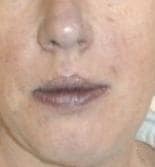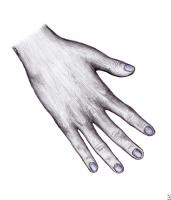We are going to explore water pollution diseases in details- some of the diseases that are sectional.
First is Cyanosis
In January 1993, Mr. Yoon went to hospital because of his 10-month baby who showed the symptoms of discoloration of the body, breathing troubles, and low-oxygen. As a result of diagnosing the baby, it was found that the baby was the first cyanosis (caused by polluted drinking water) patient in Korea. The professor who examined this baby said that he wondered why no heart trouble was found in the baby through ultrasonography.
However, hearing that the baby’s mother reconstituted the powdered milk in underground water in her mother’s house and gave it to her baby, the professor examined the dynamics including a water quality test and found that the underground water contained 30~298ppm of nitrate.
The above is the first case of cyanosis found in Korea. Cyanosis appears when a person has a gifted heart trouble or any trouble with the lung, but cyanosis caused by water pollution was first in Korea at that time. Cyanosis is the disease that the nitrate contained in polluted water joins together with hemoglobin in the body so the supply of oxygen becomes difficult. The reason for giving the name of cyanosis is that the whole body is changed blue due to a lack of oxygen. In general, 1~2% of the hemoglobin in the body exists in the form of methaemoglobin, but in case this rate exceeds over 10%, cyanosis appears, and 30~40%-methaemoglobin causes anoxia. This disease is not found in adults and it is usually found in newly-born babies (younger than 100 days).
Unlike general milk, powdered milk is known to make the influence of nitrates in polluted water big. However, boiling water can’t be a solution. Even boiling water can increase the concentration of nitrates because water evaporates.
In addition, nitrates can come into the body through foods in addition to water. In developing countries that people drink unsanitary water, cyanosis appears frequently, the reason for which is that they drink polluted underground water like well water instead of water supply.
Next is Itai-Itai Disease (Japan)
The symptoms of Itai-Itai disease were first observed in 1913 and characterized between 1947 and 1955; it was 1968, however, before the Japanese Ministry of Health and Welfare officially declared that the disease was caused by chronic cadmium poisoning in conjunction with other factors such as the stresses of pregnancy and lactation, aging, and dietary deficiencies of vitamin D and calcium. The name arose from the cries of pain, "itai-itai" (ouch-ouch) by the most seriously stricken victims, older Japanese farm women. Although men, young women, and children were also exposed, 95% of the victims were post-menopausal women over 50 years of age. They usually had given birth to several children and had lived more than 30 years within 2 mi (3 km) of the lower stream of the Jinzu River near Toyama.
The disease started with symptoms similar to rheumatism, neuralgia, or neuritis. Then came bone lesions, osteomalacia, andosteoporosis, along with renal disfunction and proteinuria. As it escalated, pain in the pelvic region caused the victims to walk with a duck-like gait. Next, they were incapable of rising from their beds because even a slight strain caused bone fractures. The suffering could last many years before it finally ended with death. Overall, an estimated 199 victims have been identified, of which 162 had died by December 1992.
The number of victims increased during and after World War II as production expanded at the Kamioka Mine owned by the Mitsui Mining and Smelting Company. As 3,000 tons of zinc-lead ore per day were mined and smelted, cadmium was discharged in thewastewater. Downstream, farmers withdrew the fine particles offlotation tailings in the Jinzu River along with water for drinking and crop irrigation. As rice plants were damaged near the irrigation inlets, farmers dug small sedimentation pools that were ineffective against the nearly invisible poison.
Both the numbers of Itai-Itai disease patients and the damage to the rice crops rapidly decreased after the mining company built a large settling basin to purify the wastewater in 1955. However, even after the discharge into the Jinzu River was halted, the cadmium already in the rice paddy soils was augmented by airborne exhausts. Mining operations in several other Japanese prefectures also produced cadmium-contaminating rice, but afflicted individuals were not certified as Itai-Itai patients. That designation was applied only to those who lived in the Jinzu River area.
In 1972 the survivors and their families became the first pollutionvictims in Japan to win a lawsuit against a major company. They won because in 1939 Article 109 of the Mining Act had imposed strict liability upon mining facilities for damages caused by their activities. The plaintiffs had only to prove that cadmium discharged from the mine caused their disease, not that the company was negligent. As epidemiological proof of causation sufficed as legal proof in this case, it set a precedent for other pollution litigation as well.
Despite legal success and compensation, the problem of contaminated rice continues. In 1969 the government initially set a maximum allowable standard of 0.4 parts per million (ppm) cadmium in unpolished rice. However, because much of the contaminated farmland produced grain in excess of that level, in 1970 under the Foodstuffs Hygiene Law this was raised to 1 ppm cadmium for unpolished rice and 0.9 ppm cadmium for polished rice. To restore contaminated farmland, Japanese authorities instituted a program in which, each year, the most highly contaminated soils in a small area are exchanged for uncontaminated soils. Less contaminated soils are rehabilitated through the addition of lime, phosphate, and a cadmium sequestering agent, EDTA.
By 1990 about 10,720 acres (4,340 ha), or 66.7% of the approximately 16,080 acres (6,510 ha) of the most highly cadmium contaminated farmland had been restored. In the remaining contaminated areas where farm families continue to eat homegrown rice, the symptoms are alleviated by treatment with massive doses of vitamins B1, B12, D, calcium, and various hormones. New methods have also been devised to cause the cadmium to be excreted more rapidly. In addition, the high costs of compensation and restoration are leading to the conclusion that prevention is not only better but cheaper. This is perhaps the most encouraging factor of all.
Itai-Itai disease photos were sufficiently disturbing so I excluded them.
Last one is Minamata Disease
In the mid 1950s the people of Minamata, Japan, on the coast of the Shiranui Sea, began to notice something wrong with the cats in their town. The cats appeared to be going insane, and were falling into the sea. The people thought the cats were committing suicide.
Soon the people in the town were also contracting a strange illness. Individuals began to have numbness in their limbs and lips. Some had difficulty hearing or seeing. Others developed shaking (tremors) in their arms and legs, difficulty walking, even brain damage. Others seemed to be going crazy, shouting uncontrollably.
Unknown syndrome called Minamata disease
In 1956, researchers worked to find the source of the illness, which they termed Minamata disease. Something was affecting the nervous systems of the people. One thing people in this fishing town had in common was that they all ate fish, so scientists suspected that the fish in Minamata Bay were being poisoned.
Chisso Corporation source of environmental pollution
A large petrochemical plant in Minamata run by Chisso Corporation was immediately suspect. Chisso denied the allegations and continued its manufacturing with no changes to the method of production. Finally, in July 1959 researchers from Kumamoto University found that organic mercury was the cause of Minamata disease.
Chisso continued to refute the information and any link of its mercury waste to the illness. It was later discovered that Chisso Corporation had dumped an estimated 27 tons of mercury compounds into Minamata Bay.
People severely affected
As the mercury dumping continued, babies were born to poisoned mothers. The children were born with severe deformities, including gnarled limbs, mental retardation, deafness, and blindness. A photographer, W. Eugene Smith, traveled to Minamata in the 1970s, and his series of photographs of the suffering of the people there were published and seen around the world.
The people fight back
The fishermen of Minamata began protesting against Chisso Corporation in 1959. They demanded compensation, and that Chisso quit dumping toxic waste. Chisso in turn tried to make deals with people affected by mercury poisoning using legal documents that stated it would compensate individuals for their illnesses, but would accept no present or future liability. Many people felt this was their only chance at receiving any compensation, and signed the papers.
A poisoning epidemic
Chisso finally quit poisoning the waters in Minamata in 1968. According to Japanese government figures, 2,955 people contracted Minamata disease, and 1,784 people have since died. Researchers believe, however, that the criteria the government uses to diagnose Minamata disease is too strict, and that anyone who showed any impairment in his/her senses should be certified as a victim. A group of these yet-to-be-recognized victims plans to file a compensation suit against the government.
Government also held liable
In October 1982, 40 plaintiffs filed suit against the Japanese government, saying it had failed to stop Chisso from polluting the environment, and had actually looked the other way while Chisso violated pollution laws. In April 2001 the Osaka High Court determined that the government's Health and Welfare Ministry should have begun taking regulatory action to stop the poisoning at the end of 1959, after it concluded that Minamata disease was caused by mercury poisoning. The court also ordered Chisso to pay $2.18 million in damages to the plaintiffs.
Supreme Court orders payment of damages
On October 16, 2004, the Supreme Court of Japan ordered the government to pay 71.5 million yen ($703,000) in damages to the Minamata disease victims. The Environment Minister bowed in apology to the plaintiffs. After 22 years, the plaintiffs achieved their goal of making those responsible for Japan's worst case of industrial pollution pay for their negligence. No amount of money, though, can ever make up for the lives needlessly lost to Minamata disease.
Information for this article was taken from:
- American University, The School of International Service.
Minamata disaster.
- Kyodo News. Unrecognized Minamata disease patients to sue government. Japan Today, October 17, 2004.
- Mizoguchi, K. Court orders damages paid to Japan poisoning victims. The Boston Globe, October 16, 2004.
- Olson, D. A. (2002). Mercury. eMedicine, accessed at http://www.emedicine.com/neuro/topic617.htm
- Tanaka, F. Negligence clear in Minamata case. The Daily Yomiuri, October 17, 2004.
Comments : There is a misconception that water pollution only affects in the environment, but not as much as on humans. However, this is axiomatically wrong because there are many different diseases that you have to account for. Different chemicals that pollute the water brings out different physical and biological effect on our bodies. I always thought that boiling water would solve any kind of disease related to drinking water, however I found out that in some cases boiling water only increases the concentration of certain toxic chemical substances.





